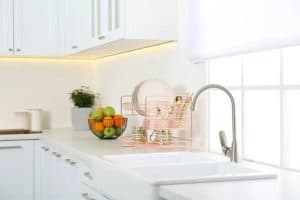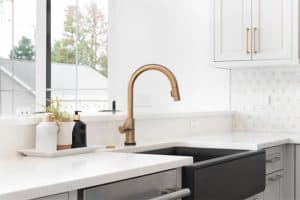Marble has long been revered for its timeless beauty and luxurious appeal, making it a popular choice for kitchen countertops. However, it’s not without its drawbacks, such as being prone to staining, scratching, and requiring regular maintenance. Thankfully, there is an array of stunning alternatives available that offer both aesthetic appeal and practicality.
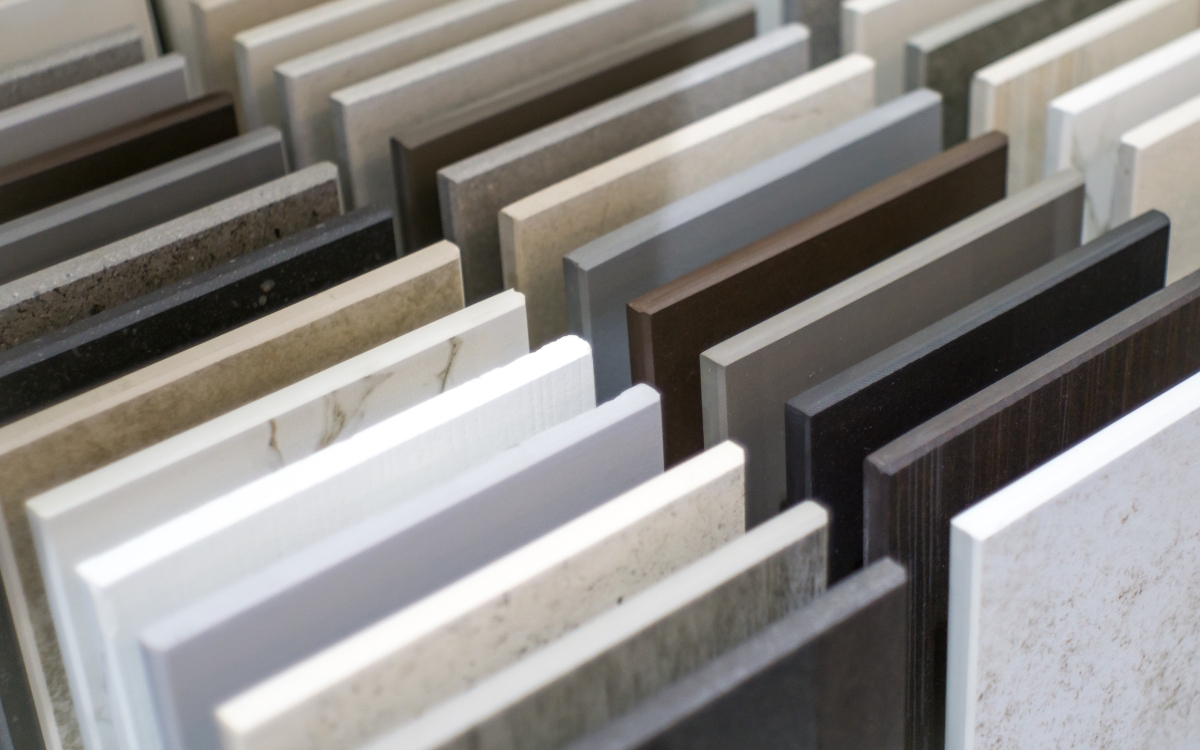
In this blog post, we will delve into five compelling alternatives to marble countertops, each with its unique set of benefits and features. Whether you’re looking for durability, affordability, customizability, or low maintenance, there’s a perfect option for you. So let’s dive in and discover the wonderful world of quartz, granite, soapstone, laminate, and concrete countertops. Say goodbye to the limitations of marble and embrace the possibilities these alternatives have to offer!
Quartz Countertops: A Durable and Low-Maintenance Choice
The Composition and Manufacturing Process of Quartz Countertops
Quartz countertops are crafted from approximately 90-95% crushed natural quartz crystals, which are one of the hardest minerals found in nature. The quartz is combined with polymer resins, pigments, and sometimes recycled materials, creating a highly engineered slab with superior strength and consistency. The manufacturing process involves pressing the mixture under intense pressure and curing it in ovens, resulting in a non-porous and uniform surface that is resistant to scratches and stains.
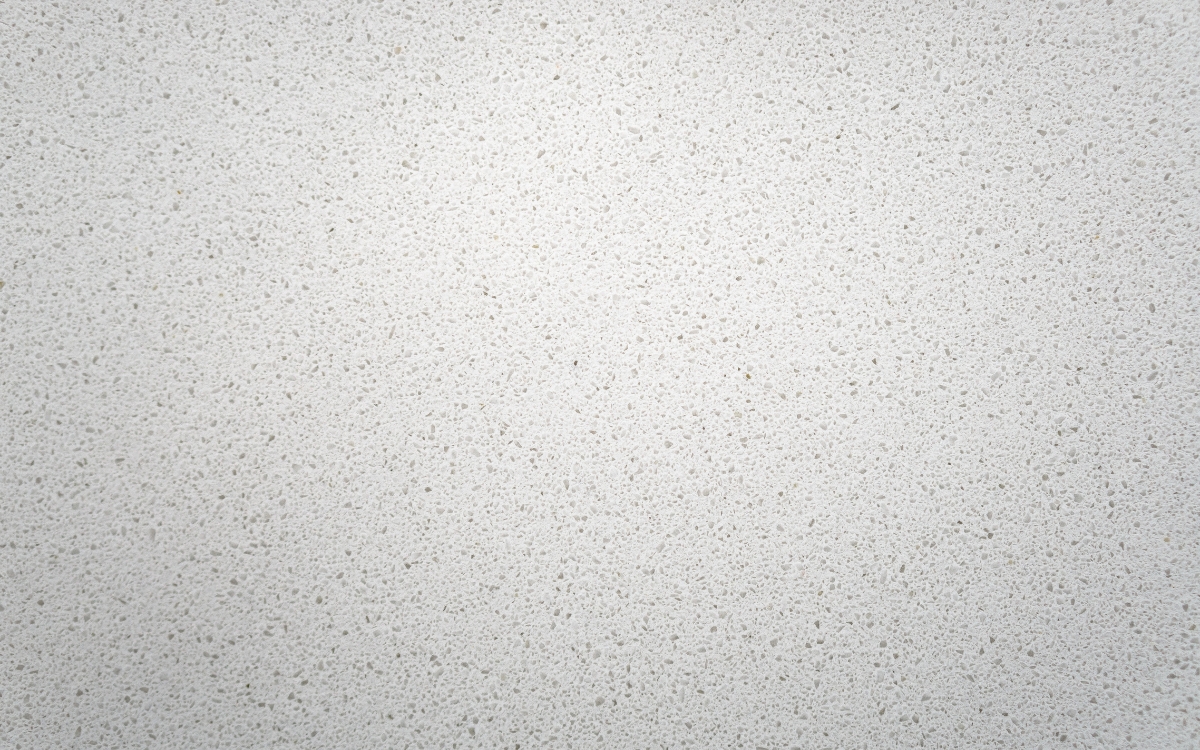
Advantages of Quartz Countertops
One of the standout features of quartz countertops is their exceptional durability. The combination of natural quartz and resin results in a surface that can withstand the daily wear and tear of a busy kitchen without chipping or cracking. Additionally, quartz is non-porous, meaning it does not absorb liquids, making it highly resistant to staining from spills and food items.
Quartz countertops are also a hygienic choice for kitchens, as their non-porous nature prevents the growth of bacteria and other harmful microorganisms. This quality makes them an ideal option for food preparation areas where cleanliness is of utmost importance.
A Wide Range of Colors and Patterns
Unlike natural stones like marble, which have limited color options, quartz countertops come in a vast array of colors and patterns. Manufacturers can create an extensive range of designs, from classic marble-inspired veining to contemporary solid colors. This versatility allows homeowners to find a quartz countertop that perfectly complements their kitchen decor and personal style.
Comparing Quartz to Marble: Cost-Effectiveness and Ease of Maintenance
While marble exudes elegance, it often comes with a hefty price tag and requires meticulous maintenance to preserve its beauty. On the other hand, quartz provides a cost-effective alternative with minimal upkeep requirements. Its durable nature and stain resistance make it an excellent long-term investment, as it will retain its original appearance for years with proper care. Homeowners can enjoy the luxurious look of marble without the continuous maintenance headaches by choosing quartz as their countertop material of choice.
Granite Countertops: Timeless Elegance with Natural Appeal
Understanding the Formation and Characteristics of Granite
Granite is an igneous rock primarily composed of feldspar, quartz, mica, and other minerals. Its formation occurs deep within the earth’s crust when magma cools and solidifies slowly over time. The slow cooling process allows large mineral crystals to form, giving granite its signature speckled appearance and eye-catching patterns.
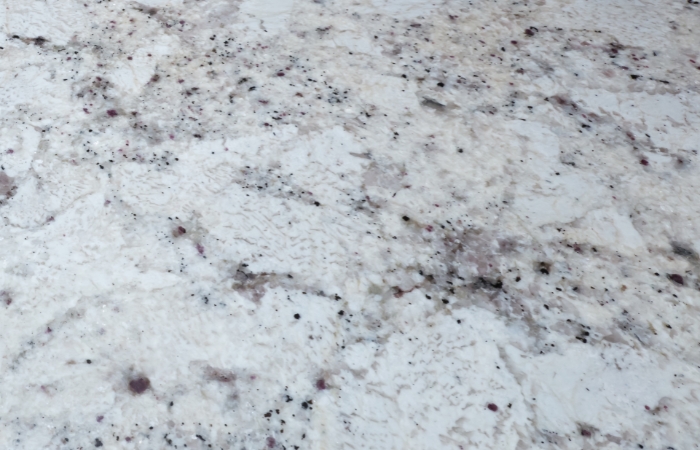
One of the key characteristics that set granite apart is its remarkable hardness and durability. This natural stone is exceptionally resistant to scratches, heat, and impact, making it an ideal material for high-traffic areas like kitchen countertops. Additionally, each slab of granite is unique, boasting a mesmerizing blend of colors and patterns that cannot be replicated.
The Unique and Varied Patterns Found in Granite Slabs
Granite offers a stunning range of patterns, colors, and textures, making it a versatile choice for various kitchen designs. From classic speckles to intricate veining and bold swirls, each granite slab presents a work of art from nature. Homeowners can find granite countertops that effortlessly complement their kitchen decor, creating a focal point that draws admiration from all who enter the space.
Heat and Scratch-Resistant Properties Make it Ideal for Busy Kitchens
Granite’s exceptional resistance to heat and scratches is a major advantage for those who love to cook and entertain. You can place hot pots and pans directly on the surface without fear of damage, and the stone’s hardness ensures that cutting and chopping won’t leave unsightly marks. This durability ensures that your granite countertop will maintain its flawless appearance, even with the rigors of daily use.
Granite Maintenance Tips for Lasting Beauty
While granite is a durable and low-maintenance option for kitchen countertops, a little care goes a long way in preserving its natural beauty. Sealing the granite regularly will help prevent stains and make cleaning a breeze. Routine cleaning with mild soap and water is sufficient to keep the surface looking immaculate. Avoid using harsh chemicals or abrasive cleaners that may harm the sealant and the stone’s surface.
Soapstone Countertops: Rustic Charm and Distinctive Aging
The Distinctive Features and Benefits of Soapstone
Soapstone is a metamorphic rock composed primarily of talc, which gives it a smooth and almost soapy feel when touched – hence the name “soapstone.” This unique texture sets soapstone apart from other countertop materials and creates a sensory experience that is both comforting and luxurious.
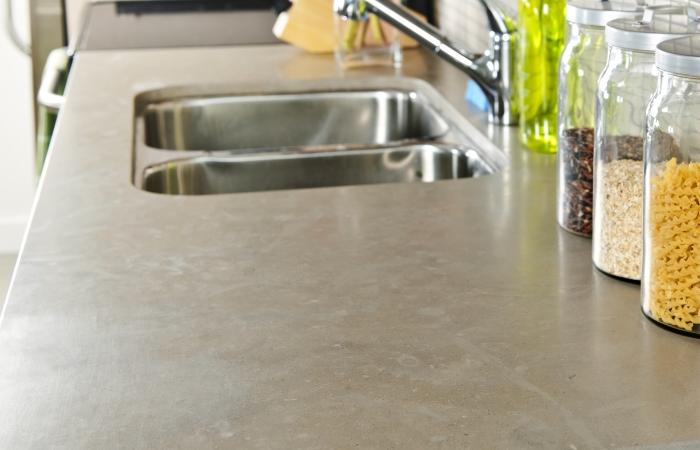
One of the most remarkable benefits of soapstone countertops is their resistance to heat. This natural stone can withstand high temperatures without scorching or cracking, making it ideal for busy kitchens where hot pots and pans are frequently placed on the surface.
How Soapstone Develops a Natural Patina Over Time
One of the most alluring aspects of soapstone countertops is their ability to age gracefully, developing a natural patina over time. With exposure to air and use, the soapstone surface will darken, enhancing its beauty and character. This aging process adds depth and richness to the stone, creating a look that is truly one-of-a-kind.
As soapstone darkens and develops its patina, it may also acquire slight surface scratches and nicks, but these often blend seamlessly into the stone’s texture, further contributing to its rustic appeal. The patina of soapstone countertops tells a story of years of use and adds a sense of history and warmth to the kitchen.
Heat Resistance and Ability to Withstand Acidic Substances
Apart from its heat resistance, soapstone also has the advantage of being non-porous, making it resistant to staining. This property is particularly valuable in a kitchen where spills and splatters are common. Unlike other natural stones, soapstone does not require sealing to protect it from stains and spills.
Furthermore, soapstone is chemically inert and does not react with acidic substances, such as lemon juice or vinegar. This makes it an excellent surface for food preparation, as it won’t be damaged or discolored by acidic ingredients.
Enhancing Soapstone with Mineral Oil for a Rich, Dark Hue
If you desire to accelerate the darkening process and enhance the beauty of your soapstone countertop, you can apply mineral oil regularly. The oil will deepen the color and enrich the appearance of the stone, bringing out the unique veining and patterns inherent in soapstone. This application of mineral oil also helps to maintain the stone’s smooth texture and highlights its natural elegance.
Laminate Countertops: Affordable and Versatile Designs
The Process of Creating Laminate Countertops
Laminate countertops are created through a lamination process that involves bonding multiple layers of synthetic materials together. The core of the countertop is usually made from particleboard or medium-density fiberboard (MDF), which provides stability and support. The top layer is a decorative sheet printed with various patterns and designs, such as stone, wood, or solid colors. A protective layer of clear resin is then applied to shield the decorative sheet from wear and tear.
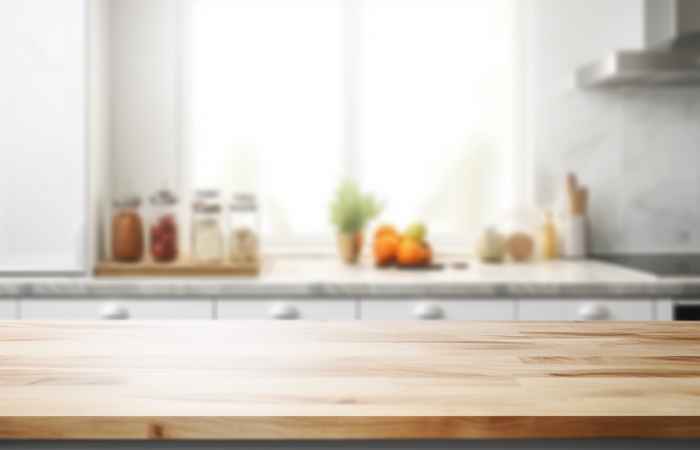
Endless Design Possibilities and Patterns Available
One of the most significant advantages of laminate countertops is the wide range of design options available. Manufacturers can replicate the appearance of various natural materials, allowing homeowners to achieve the look of expensive stone surfaces without the associated costs. Whether you desire the classic elegance of marble, the warmth of wood, or a modern solid color, laminate countertops offer an abundance of choices to suit any kitchen style.
The versatility of laminate also extends to its edge profiles. Homeowners can choose from various edge styles, including beveled, squared, or bullnose edges, to further customize the appearance of their countertops.
Budget-Friendly Option with Easy Installation
One of the primary reasons why laminate countertops remain popular is their affordability. Compared to natural stone or engineered quartz surfaces, laminate countertops come at a fraction of the cost, making them an attractive option for budget-conscious homeowners. This affordability allows you to allocate more resources to other aspects of your kitchen renovation or design.
Additionally, laminate countertops are relatively easy to install, which further contributes to their cost-effectiveness. Professional installation is not always necessary, and many homeowners with basic DIY skills can successfully install laminate countertops themselves. This DIY-friendly nature of laminate countertops saves both time and money during the renovation process.
How to Care for and Maintain Laminate Countertops
While laminate countertops are durable and low-maintenance, proper care is essential to keep them looking their best over time. Avoid using harsh abrasives or abrasive cleaners, as they may scratch or damage the surface. Instead, clean the countertop with mild soap and warm water, and wipe up spills promptly to prevent staining.
Though laminate countertops are relatively resistant to heat, it is advisable to use trivets or hot pads when placing hot pots and pans on the surface. Prolonged exposure to high heat can cause the laminate to discolor or delaminate.
Concrete Countertops: Customizable and Modern Aesthetics
The Versatility of Concrete in Countertop Design
One of the standout features of concrete countertops is their unparalleled versatility. Unlike other countertop materials, concrete is poured and molded into custom shapes and sizes, allowing for truly unique designs tailored to your specific preferences. From seamless and flowing curves to sharp and angular edges, concrete can be adapted to suit any kitchen layout, be it traditional or contemporary.
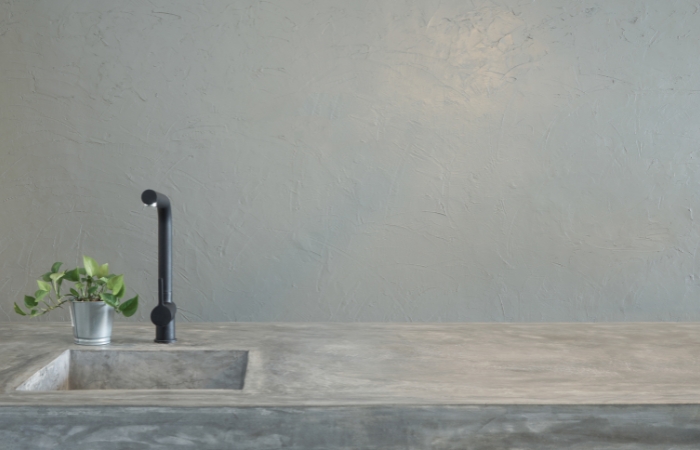
Beyond shaping, concrete countertops can be customized with a myriad of design elements. Integrating various aggregates, such as crushed glass, stones, or seashells, adds texture and visual interest. Pigments and dyes can be used to create a vast spectrum of colors, ranging from neutral tones to vibrant hues, enabling you to personalize the look to match your kitchen’s decor.
Creating Custom Shapes, Colors, and Textures with Concrete
With concrete countertops, the possibilities for creativity are virtually limitless. The concrete can be cast in intricate molds to achieve artistic patterns and designs, such as geometric motifs or intricate engravings. This level of customization allows you to create a countertop that becomes a statement piece, a work of art that captivates and draws attention.
Additionally, concrete countertops can be finished in various ways to achieve different textures. From a high-gloss polished surface that gleams with sophistication to a more rustic and tactile honed or brushed finish, you can choose the texture that best complements your kitchen’s overall aesthetic.
The Importance of Proper Sealing for Durability
While concrete countertops offer incredible visual appeal and customization options, it is essential to understand the importance of proper sealing to ensure their durability and longevity. Concrete is porous and prone to staining, particularly from acidic substances. Applying a high-quality sealant not only protects the surface from staining but also enhances its resilience to scratches and heat.
Regular maintenance, such as resealing every few years, will help maintain the concrete’s integrity and keep it looking beautiful for years to come. Proper care, such as avoiding cutting directly on the surface and using trivets for hot items, will further extend the life of your concrete countertops.
Concrete Countertops as a DIY Project or Hiring a Professional
Concrete countertops can be fabricated as a DIY project for those with some experience in working with concrete and construction materials. However, due to the precision and expertise required, many homeowners opt to hire professional craftsmen to ensure a flawless result. Experienced professionals can help you navigate the various design options, ensure proper sealing, and achieve a high-quality finish that meets your expectations.
Conclusion
For those seeking a resilient and low-maintenance choice, quartz countertops stand out as a durable and visually appealing option. Granite countertops offer a timeless elegance with their unique patterns and natural allure, making them a lasting investment. Soapstone countertops exude rustic charm and develop character over time, adding a touch of individuality to your kitchen.
If you’re on a budget and looking for versatility, laminate countertops provide an abundance of design choices at an affordable cost. For those who desire modern aesthetics and customized designs, concrete countertops open up a realm of creative possibilities.
Ultimately, the decision on which alternative to choose depends on your personal needs and preferences. Consider the level of maintenance you’re willing to undertake, the style you wish to achieve, and the durability required to withstand your kitchen’s daily demands.



